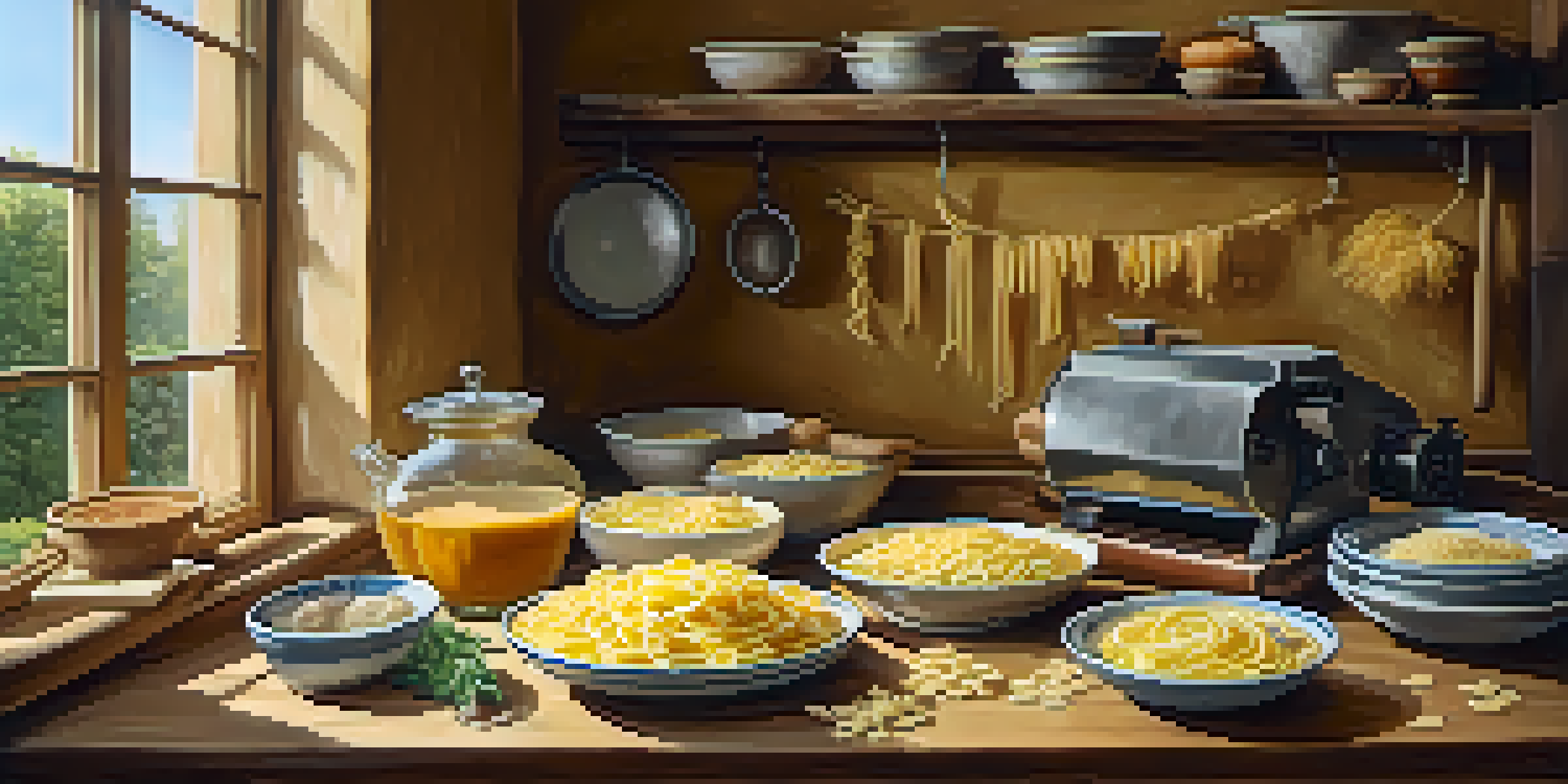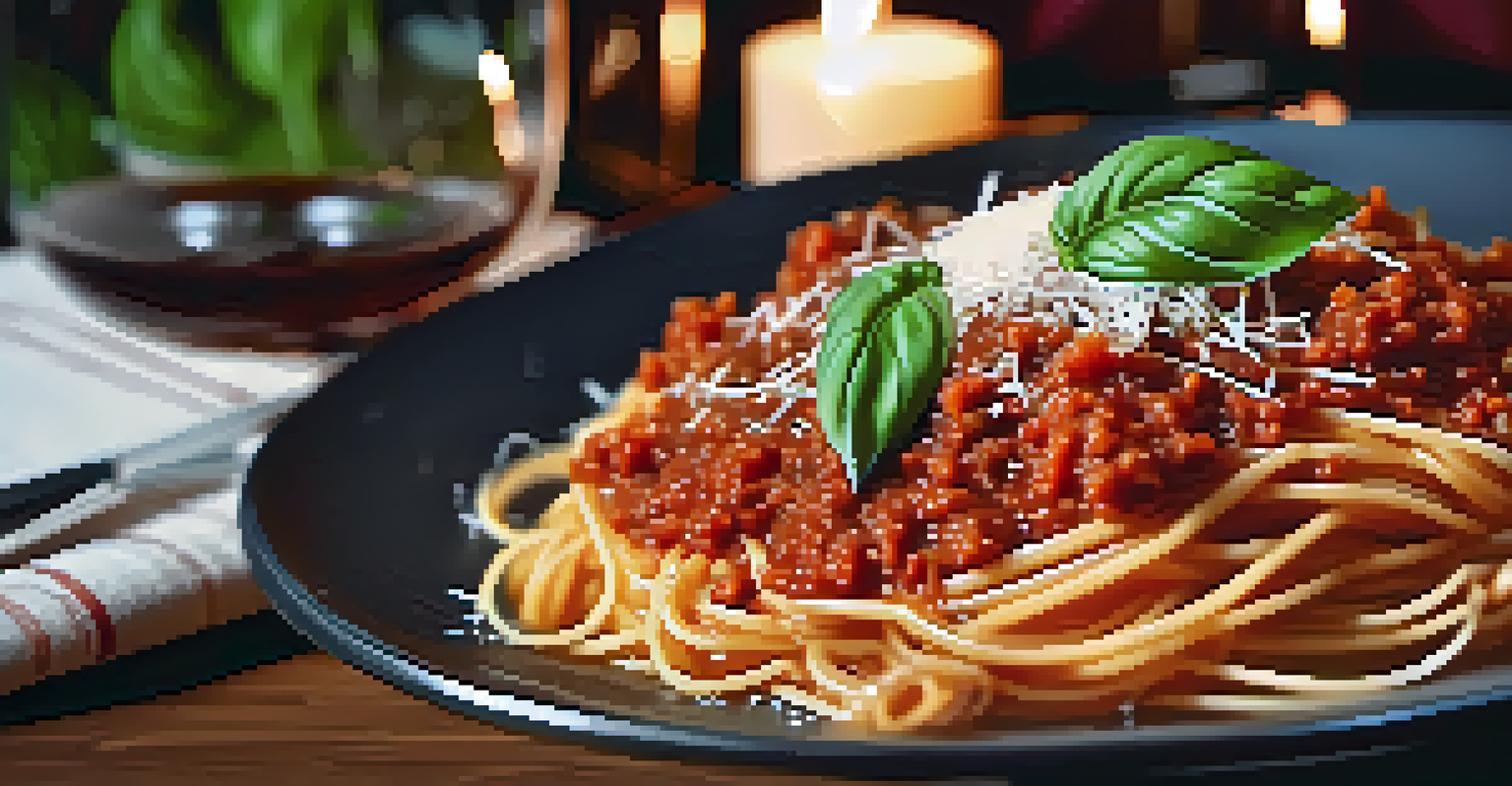Traditional Italian Cooking: Mastering Authentic Pasta Dishes

The Rich History Behind Traditional Italian Pasta
Italian pasta has a history that dates back centuries, intertwined with the culture and traditions of Italy. Originating from simple ingredients like flour and water, pasta has evolved into a beloved staple recognized worldwide. Each region in Italy boasts its own unique pasta shapes and recipes, reflecting local ingredients and culinary practices.
Life is a combination of magic and pasta.
For example, the famous tagliatelle from Emilia-Romagna is often paired with a rich ragù sauce, showcasing the region's love for hearty flavors. In contrast, the lighter, seafood-based pasta dishes of the Amalfi Coast highlight the freshness of the Mediterranean. This regional diversity makes Italian pasta not just a dish but a journey through Italy's landscape and heritage.
Understanding this historical context can deepen your appreciation for pasta dishes. When you savor a plate of spaghetti, you’re not just enjoying a meal; you’re connecting with centuries of tradition that celebrate family, community, and the joy of sharing good food.
Essential Ingredients for Authentic Pasta Making
Creating authentic Italian pasta starts with choosing the right ingredients. The basic components include high-quality flour—preferably '00' flour for its fine texture—and fresh eggs. While some recipes call for just flour and water, using eggs can add richness and a delightful flavor to your pasta.

Another critical ingredient is salt, as it enhances the overall taste of the dough. Remember, salt is your friend, but too much can overpower the dish. Additionally, consider using fresh herbs and spices, which can elevate your pasta dish and reflect the regional flavors of Italy.
Pasta's Rich Regional Diversity
Italian pasta showcases unique shapes and flavors from different regions, making each dish a reflection of local traditions.
Investing in quality ingredients not only improves the taste but also honors the traditional Italian cooking philosophy of using fresh, seasonal produce. When you create pasta from scratch, you’re setting the stage for an authentic dining experience that’s both delicious and meaningful.
Mastering the Art of Pasta Dough
Making pasta dough might seem daunting, but it’s all about technique and practice. Start by placing your flour on a clean surface, creating a well in the center, and adding your eggs. Gradually incorporate the flour into the eggs using a fork until the dough comes together.
Pasta is the one food that brings people together.
Once you have a rough dough, knead it for about 10 minutes until it becomes smooth and elastic. This process is crucial, as it develops the gluten, giving your pasta that perfect chewy texture. If the dough feels too sticky, a little extra flour can help; just be careful not to overdo it.
After kneading, let the dough rest for at least 30 minutes, covered with a cloth. This resting period relaxes the gluten and makes it easier to roll out. Remember, patience is key in this process, and the rewards are well worth the effort when you taste the results.
Rolling and Shaping Your Pasta: Techniques to Try
Once your dough has rested, it’s time to roll and shape it into your desired pasta form. You can use a pasta machine or a rolling pin; both methods can yield great results. If you’re using a pasta machine, start with the widest setting and gradually move to thinner settings to achieve the perfect thickness.
For shaping, the possibilities are endless—think fettuccine, ravioli, or even lasagna sheets. Use a sharp knife or a pasta cutter for precise shapes, and don’t forget to dust your work surface with flour to prevent sticking. If you’re feeling adventurous, try your hand at stuffed pasta like tortellini, which can be a fun way to incorporate innovative fillings.
Key Ingredients for Authentic Pasta
Using high-quality ingredients like '00' flour and fresh eggs is essential for creating rich, flavorful pasta.
Remember, practice makes perfect. The more you roll and shape, the more comfortable you’ll become with the techniques, and soon you’ll be churning out beautiful pasta dishes like a true Italian nonna!
Cooking Your Pasta: Timing is Everything
Cooking pasta might seem straightforward, but timing is crucial for achieving that al dente perfection. Start by bringing a large pot of salted water to a rolling boil before adding your pasta. The salt enhances the flavor and helps the pasta absorb it while cooking.
Once you add the pasta, keep an eye on the clock. Check the package for recommended cooking times, but always taste a piece a minute or so before it's due to see if it’s cooked to your liking. Al dente pasta should be firm to the bite, not mushy, ensuring it holds up well when combined with your sauce.
After cooking, remember to reserve a cup of pasta water before draining. This starchy water can be a game-changer when making sauces, as it helps to bind the sauce to the pasta, creating a cohesive and flavorful dish.
Creating Authentic Italian Sauces: A Flavor Journey
No pasta dish is complete without a delicious sauce, and Italian cuisine offers a plethora of options ranging from simple to complex. A classic tomato sauce, or 'sugo', can be made by simmering crushed tomatoes with garlic, olive oil, and fresh basil. This combination is not only easy to prepare but captures the essence of Italian flavor.
For something richer, consider a creamy Alfredo or a hearty Bolognese sauce. Each sauce has its origins and is often paired with specific pasta shapes for optimal flavor and texture. For instance, a chunky Bolognese goes well with tagliatelle, as the sauce clings to the wider noodles beautifully.
The Importance of Cooking Timing
Perfect timing is crucial when cooking pasta to achieve that ideal al dente texture, enhancing the overall dining experience.
Experimenting with different sauces is a delightful way to discover your personal tastes. Whether you prefer light and fresh or rich and robust, creating a sauce from scratch can elevate your pasta experience and connect you more deeply with Italian culinary traditions.
Serving and Enjoying Your Pasta Dish: The Italian Way
In Italy, the way you serve and enjoy pasta is almost as important as how it’s made. Traditionally, pasta is served as a first course, or 'primo', setting the stage for the rest of the meal. It’s often accompanied by a light salad or antipasto, allowing the pasta to shine as the star of the show.
When serving, remember to use a large bowl or platter to present the pasta beautifully. Garnish with fresh herbs, a drizzle of quality olive oil, or freshly grated cheese to enhance the visual appeal. Italians often emphasize the importance of enjoying food together, so gather your friends and family around the table for a true Italian dining experience.

Lastly, don’t forget to pair your meal with a suitable wine, as this can enhance the flavors of your dish. Enjoying pasta is not just about the food; it’s about savoring the moment and creating memories with those you love.